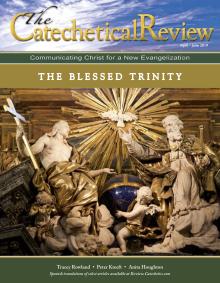Because the mystery of the Most Holy Trinity “is the central mystery of the Christian faith and of Christian life”[1] it is nearly impossible to exaggerate its importance in all catechesis, including that of children. But how can we possibly convey to children this holy mystery, which even well-educated theologians admit is beyond human understanding? Trinitarian Beginnings Asking how we can best teach children about the Trinity is akin to asking how we ought to teach children about their mother and father and siblings. Ideally, children are born into a family and welcomed into the pre-existing communion of love between their mother and father. By the act of joining together and making a family, man and woman reflect (though imperfectly) the trinitarian mystery. The following quote from St. John Paul II helps us see that the experience of family life is meant to image the Trinity, which he calls the divine “We.” In the light of the New Testament it is possible to discern how the primordial model of the family is to be sought in God himself, in the Trinitarian mystery of his life. The divine “We” is the eternal pattern of the human “we”, especially of that "we" formed by the man and the woman created in the divine image and likeness. The words of the Book of Genesis contain that truth about man which is confirmed by the very experience of humanity.[2] Parents are the first and most influential teachers of the life-giving, self-donating love of the Trinity. As they welcome new life, make sacrifices for whichever family member most needs love at the moment, and teach their children to do the same, they reflect the life-giving love of the Blessed Trinity. This is true whether or not the family is aware of what they are doing. The family images God; giving flesh and blood to the truth that we are made to make of ourselves gifts for others. Children first learn how to live family life by being born into a loving family. But the love they learn even in the best Catholic home is merely a faint reflection of the love they are immersed into at Baptism. Children are first immersed in the Holy Trinity the day they are baptized into the Church, born into the family of God. It is then that they receive the indelible mark of belonging to God’s family. When children are baptized in the name of the Father, and of the Son, and of the Holy Spirit, they are born into the communion of love between the three Divine Persons of the Blessed Trinity. “Baptism . . . signifies and actually brings about death to sin and entry into the life of the Most Holy Trinity through configuration to the Paschal mystery of Christ.”[3] Yet, just as it is possible to form a family but neglect to surround the children with experiences of virtue and self-donating love, so it is possible to baptize children and fail to lead them to an awareness of the communion of love we know as the Blessed Trinity. Aside from encouraging parents to live the virtues in their own families, how can catechists help families promote an awareness of trinitarian life at home?
The rest of this online article is available for current Guild members.
This article is from The Catechetical Review (Online Edition ISSN 2379-6324) and may be copied for catechetical purposes only. It may not be reprinted in another published work without the permission of The Catechetical Review by contacting [email protected]


















